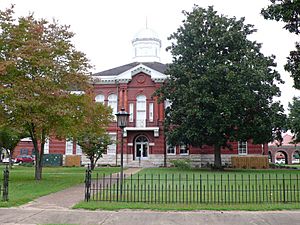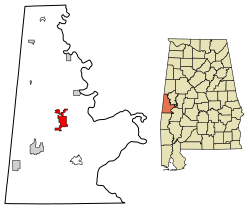Livingston, Alabama facts for kids
Quick facts for kids
Livingston, Alabama
|
||
|---|---|---|

The Sumter County Courthouse in Livingston, Alabama
|
||
|
||

Location of Livingston in Sumter County, Alabama.
|
||
| Country | United States | |
| State | Alabama | |
| County | Sumter | |
| Area | ||
| • Total | 7.21 sq mi (18.68 km2) | |
| • Land | 7.13 sq mi (18.47 km2) | |
| • Water | 0.08 sq mi (0.22 km2) | |
| Elevation | 154 ft (47 m) | |
| Population
(2020)
|
||
| • Total | 3,436 | |
| • Density | 481.91/sq mi (186.07/km2) | |
| Time zone | UTC-6 (Central (CST)) | |
| • Summer (DST) | UTC-5 (CDT) | |
| ZIP code |
35470
|
|
| Area code(s) | 205, 659 | |
| FIPS code | 01-43720 | |
| GNIS feature ID | 0152129 | |
Livingston is a city located in Sumter County, Alabama, in the United States. It's the main town, or county seat, of Sumter County. Livingston is also home to the University of West Alabama. The city officially became a town on January 10, 1835. In 2020, about 3,436 people lived there. The city was named after Edward Livingston, a famous person from New York.
Contents
Livingston's Location and Climate
Livingston is found at specific coordinates: 32°35′14″N 88°11′17″W / 32.58722°N 88.18806°W.
How Big is Livingston?
The city covers a total area of about 7.2 square miles (18.7 square kilometers). Most of this area, about 7.1 square miles (18.5 square kilometers), is land. A small part, about 0.1 square miles (0.2 square kilometers), is water.
Livingston's Weather Patterns
Livingston has a warm climate. Summers are hot, and winters are mild. The city gets a good amount of rain throughout the year. Here's a look at the average weather:
| Climate data for Livingston, Alabama, 1991–2020 normals, extremes 1891–2014 | |||||||||||||
|---|---|---|---|---|---|---|---|---|---|---|---|---|---|
| Month | Jan | Feb | Mar | Apr | May | Jun | Jul | Aug | Sep | Oct | Nov | Dec | Year |
| Record high °F (°C) | 91 (33) |
89 (32) |
90 (32) |
— | 99 (37) |
105 (41) |
106 (41) |
106 (41) |
103 (39) |
99 (37) |
88 (31) |
90 (32) |
106 (41) |
| Mean maximum °F (°C) | 74.5 (23.6) |
78.6 (25.9) |
84.0 (28.9) |
86.9 (30.5) |
91.3 (32.9) |
96.0 (35.6) |
98.1 (36.7) |
97.6 (36.4) |
94.4 (34.7) |
89.0 (31.7) |
82.1 (27.8) |
76.2 (24.6) |
99.7 (37.6) |
| Mean daily maximum °F (°C) | 57.4 (14.1) |
62.7 (17.1) |
70.3 (21.3) |
77.0 (25.0) |
83.6 (28.7) |
89.3 (31.8) |
91.5 (33.1) |
92.0 (33.3) |
86.9 (30.5) |
78.2 (25.7) |
66.7 (19.3) |
59.4 (15.2) |
76.3 (24.6) |
| Daily mean °F (°C) | 45.5 (7.5) |
49.4 (9.7) |
56.8 (13.8) |
63.6 (17.6) |
71.5 (21.9) |
78.7 (25.9) |
81.0 (27.2) |
81.0 (27.2) |
75.4 (24.1) |
64.9 (18.3) |
53.6 (12.0) |
47.1 (8.4) |
64.0 (17.8) |
| Mean daily minimum °F (°C) | 33.7 (0.9) |
36.0 (2.2) |
43.3 (6.3) |
50.2 (10.1) |
59.3 (15.2) |
68.1 (20.1) |
70.5 (21.4) |
70.0 (21.1) |
63.8 (17.7) |
51.7 (10.9) |
40.5 (4.7) |
34.9 (1.6) |
51.8 (11.0) |
| Mean minimum °F (°C) | 15.9 (−8.9) |
20.1 (−6.6) |
25.9 (−3.4) |
33.8 (1.0) |
43.5 (6.4) |
56.2 (13.4) |
63.4 (17.4) |
61.6 (16.4) |
48.8 (9.3) |
34.0 (1.1) |
25.4 (−3.7) |
18.4 (−7.6) |
12.5 (−10.8) |
| Record low °F (°C) | −5 (−21) |
5 (−15) |
14 (−10) |
24 (−4) |
31 (−1) |
42 (6) |
51 (11) |
52 (11) |
35 (2) |
24 (−4) |
13 (−11) |
2 (−17) |
−5 (−21) |
| Average precipitation inches (mm) | 5.24 (133) |
5.32 (135) |
5.00 (127) |
4.52 (115) |
4.92 (125) |
4.48 (114) |
5.43 (138) |
4.51 (115) |
3.24 (82) |
3.73 (95) |
4.83 (123) |
4.86 (123) |
56.08 (1,425) |
| Average snowfall inches (cm) | 0.1 (0.25) |
0.0 (0.0) |
0.2 (0.51) |
0.1 (0.25) |
0.0 (0.0) |
0.0 (0.0) |
0.0 (0.0) |
0.0 (0.0) |
0.0 (0.0) |
0.0 (0.0) |
0.0 (0.0) |
0.0 (0.0) |
0.4 (1.01) |
| Average precipitation days (≥ 0.01 in) | 7.7 | 6.7 | 7.3 | 6.4 | 6.3 | 7.5 | 8.4 | 6.8 | 5.4 | 4.8 | 5.9 | 7.5 | 80.7 |
| Average snowy days (≥ 0.1 in) | 0.1 | 0.0 | 0.0 | 0.1 | 0.0 | 0.0 | 0.0 | 0.0 | 0.0 | 0.0 | 0.0 | 0.0 | 0.2 |
| Source 1: NOAA (precip/precip days, snow/snow days 1981–2010) | |||||||||||||
| Source 2: National Weather Service (mean maxima/minima 1981–2010) | |||||||||||||
People of Livingston: Demographics
The number of people living in Livingston has changed over the years. Here's how the population has grown:
| Historical population | |||
|---|---|---|---|
| Census | Pop. | %± | |
| 1870 | 500 | — | |
| 1880 | 738 | 47.6% | |
| 1890 | 850 | 15.2% | |
| 1900 | 851 | 0.1% | |
| 1910 | 877 | 3.1% | |
| 1920 | 968 | 10.4% | |
| 1930 | 1,072 | 10.7% | |
| 1940 | 1,170 | 9.1% | |
| 1950 | 1,681 | 43.7% | |
| 1960 | 1,544 | −8.1% | |
| 1970 | 2,358 | 52.7% | |
| 1980 | 3,187 | 35.2% | |
| 1990 | 3,530 | 10.8% | |
| 2000 | 3,297 | −6.6% | |
| 2010 | 3,485 | 5.7% | |
| 2020 | 3,436 | −1.4% | |
| U.S. Decennial Census 2013 Estimate |
|||
Livingston's Population in 2020
In 2020, there were 3,436 people living in Livingston. There were 1,211 households and 592 families. The city is home to a diverse group of people.
| Race | Num. | Perc. |
|---|---|---|
| White | 1,176 | 34.23% |
| Black or African American | 2,009 | 58.47% |
| Native American | 20 | 0.58% |
| Asian | 96 | 2.79% |
| Pacific Islander | 1 | 0.03% |
| Other/Mixed | 56 | 1.63% |
| Hispanic or Latino | 78 | 2.27% |
Livingston's Population in 2010
Back in 2010, Livingston had 3,485 residents. About 63.8% of the people were African American. Around 34.4% were White. Other groups included Native American, Asian, and people of two or more races. A small percentage were Hispanic or Latino.
Livingston's Past: A Look at History
The land where Livingston now stands was once the home of the Choctaw Indians. In 1830, after the Treaty of Dancing Rabbit Creek, most of the Choctaw people moved to what is now Oklahoma. After they left, new settlers from other states like the Carolinas and Georgia came to the area. They built the first community near the current Courthouse Square.
Founding and Early Days
In 1833, a group was formed to create Sumter County. Livingston was chosen as the county seat, meaning it would be the main town for the county's government. It was named after Edward Livingston, a well-known leader and judge. Soon, the town got its first newspaper, The Voice of Sumter. Four schools were also built, including the Livingston Female Academy, which later became The University of West Alabama.
The first courthouse was made of logs. Later, a new wooden courthouse was built in 1839. This building burned down in 1901. However, the Probate Judge's office, built at the same time, survived the fire and is still used today by the county commission.
The Famous Bored Well
In the late 1800s, Livingston became known as a health spa. This was thanks to the water from its "Bored Well." This special well was dug in 1857. It reached an artesian aquifer, which is a natural underground water source. People believed the water had healing powers. A Chinese-style building was built over the well. In 1924, a new pavilion replaced it.
Growth and Recognition
In the early 1900s, Livingston continued to be a health resort. It was also home to the Alabama Normal School. This school trained teachers for the new public school system. Over time, the school grew and changed its name several times, eventually becoming The University of West Alabama.
For many years, Livingston was a quiet county seat in a rural area. In the early 1960s, citizens worked hard to improve the town. They focused on its history and main street. This effort led to the town's population almost doubling in ten years. More businesses and industries also came to Livingston. In 1972, Livingston was even a finalist in the "All American Cities Competition."
Historic Places to See
Livingston has several historic buildings and sites.
- Lakewood (built in 1840) is an old mansion. Julia Tutwiler lived here when she was president of Livingston Normal College.
- The Sumter County Courthouse (built in 1902) is listed on the National Register of Historic Places. This means it's a very important historical site.
- Other historic homes and churches include the Branch-Stuart Home (1903), Inge-Moon House (1834), St. James Episcopal Church (1840), and Voss-Pate House (1850). These are all listed on the Alabama Register of Landmarks and Heritage.
Learning in Livingston: Education
Livingston is a great place for education.
- The main university in town is the University of West Alabama.
- The Sumter County School District runs public schools for Livingston students. These include Livingston Junior High School and Sumter Central High School.
- There's also a special charter school called University Charter School on the university campus.
- A private school, Sumter Academy, used to be nearby but closed in 2017.
Famous People from Livingston
Many notable people have come from Livingston, Alabama:
- Richard Arrington, Jr. was the first African American mayor of Birmingham, Alabama.
- Mario Austin is a professional basketball player.
- Willis Brewer was a former U.S. Representative for Alabama.
- Nathan Elams Cockrell helped start the Sigma Alpha Epsilon fraternity.
- Eleanor Churchill Gibbs was an important educator.
- Vera Hall was a well-known folk singer.
- Ken Hutcherson played NFL football for teams like the Dallas Cowboys and Green Bay Packers.
- Bob Simmons was a head coach for the Oklahoma State football team.
See also
 In Spanish: Livingston (Alabama) para niños
In Spanish: Livingston (Alabama) para niños


